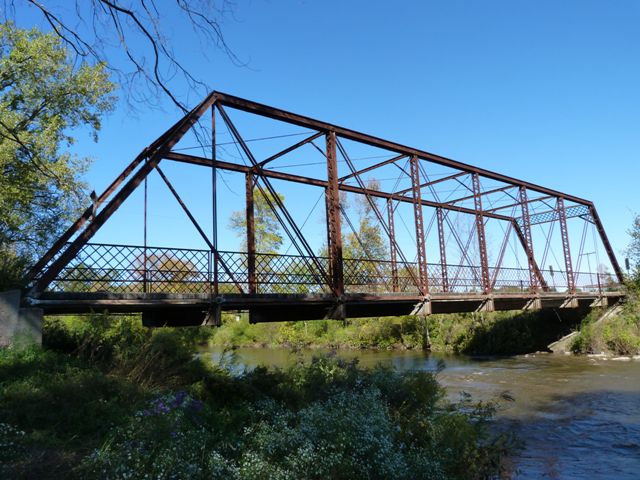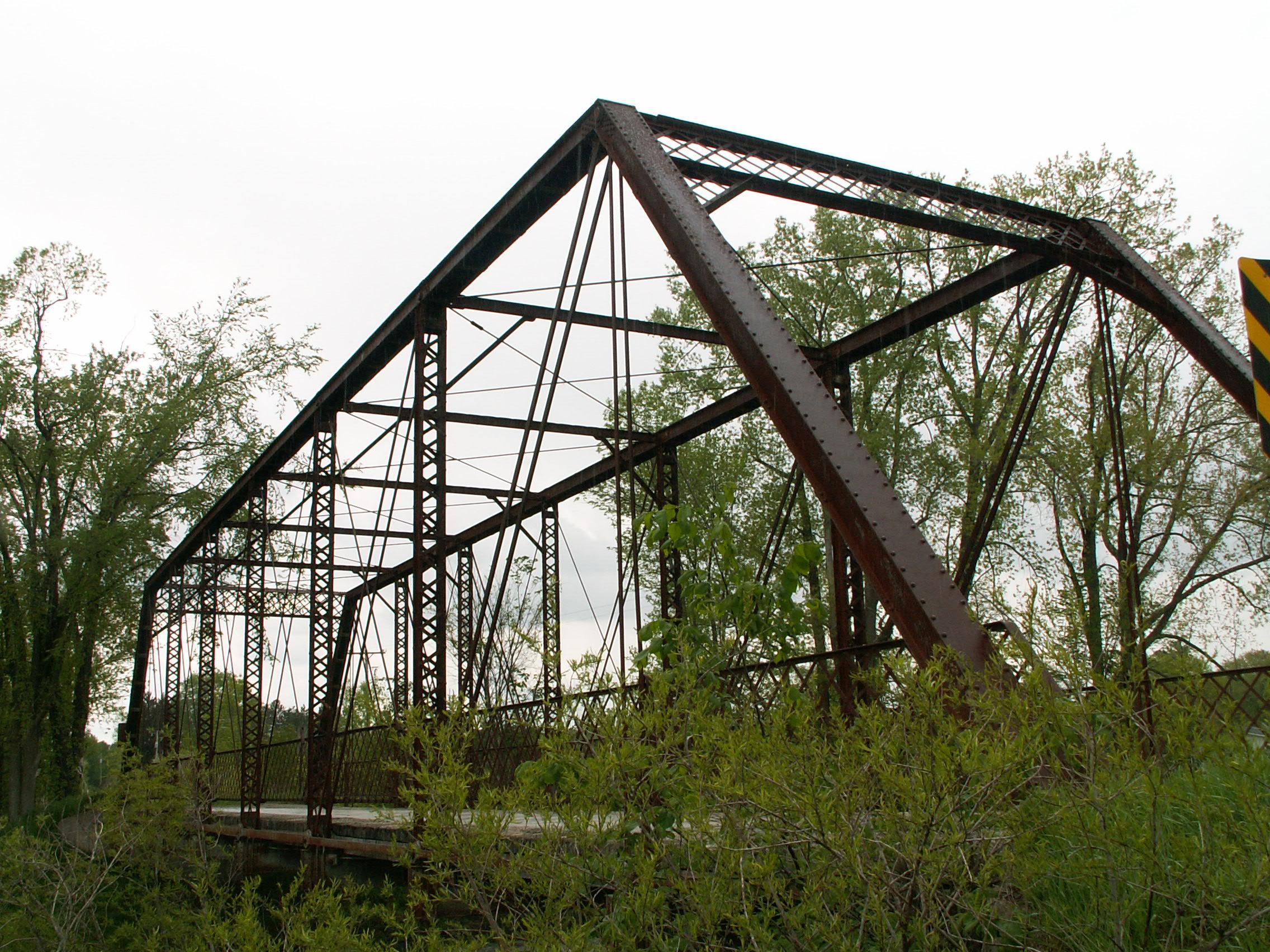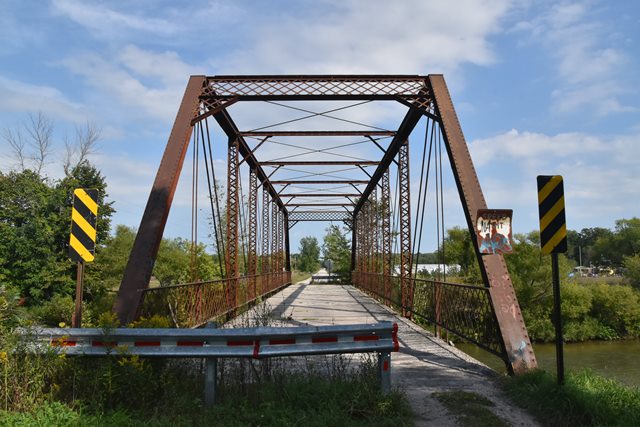We Recommend:
Bach Steel - Experts at historic truss bridge restoration.
BridgeHunter.com Phase 1 is released to the public! - Visit Now
Hickory Island Road Bridge

Primary Photographer(s): Nathan Holth
Bridge Documented: May 16, 2006, October 2, 2011, and September 5, 2016
Rural: Arenac County, Michigan: United States
By Builder/Contractor: Unknown
Not Available or Not Applicable
128.0 Feet (39 Meters)
128.0 Feet (39 Meters)
17.1 Feet (5.21 Meters)
1 Main Span(s)
06302H00005B010

View Information About HSR Ratings
Bridge Documentation
View Archived National Bridge Inventory Report - Has Additional Details and Evaluation
This is a beautiful eight panel pin connected through truss that sits on concrete abutments. The construction date given in the inventory and on MDOT's website is 1920, which is not realistic for a pin connected through truss with an old-style Carnegie stamp on the metal and thus this date is undoubtedly incorrect. This bridge would likely date to earlier than 1900, and possibly date to the late 1880s and early 1890s. This bridge features v-lacing on the vertical members. The portal bracing is a lattice design. The lattice guardrails that remain on this bridge are rather large for a rural highway bridge, in fact they are more like railings that would have been found on cantilevered sidewalks of truss bridges located in urban settings. The railings are welded to the trusses, further indication that the railings seen today are not exactly reflective of what was originally to be found on this bridge. This is an unproven theory about the history of this bridge. Looking at the ends of the floorbeams, the edge is roughly cut as if the beams were cut to length using an oxy-acetylene cutting torch. It is possible that this bridge was not originally built at this location. Instead, the bridge may have been built in an urban location, and it may have had cantilevered sidewalks on each side. At some later date, very likely 1920 since that date is apparently what the county has listed for the construction date, the bridge would have been relocated to this location. At that time, the cantilevered sidewalks would have been removed, which would have included cutting the floorbeams to shorten them. The railings from the sidewalks may have then been reused on the inside of the truss lines as vehicular guardrails. While this story is not proven and it is not known where the bridge might have come from, this would explain every unusual feature this bridge displays. It also explains why a bridge that looks like its from the 19th century sits on concrete abutments that look more like something from 1920.
Ricky Rockwell, County Clerk of Arenac County commented he had heard that a lumber company made a cut on the Rifle River and the the bridge was floated down the river to this location. While lacking in exact details, this story seems to further support the idea that this bridge was reused and relocated from some other place.
Today, this bridge has been closed to vehicular traffic. However the county reports that it has no plans to demolish the bridge, nor any to repair it. It is to remain closed to vehicular traffic but available for public viewing and pedestrian use.
|
This bridge is tagged with the following special condition(s): Unorganized Photos
![]()
Photo Galleries and Videos: Hickory Island Road Bridge
2011 Bridge Photo-Documentation
Original / Full Size PhotosA collection of overview and detail photos. This gallery offers photos in the highest available resolution and file size in a touch-friendly popup viewer.
Alternatively, Browse Without Using Viewer
![]()
2011 Bridge Photo-Documentation
Mobile Optimized PhotosA collection of overview and detail photos. This gallery features data-friendly, fast-loading photos in a touch-friendly popup viewer.
Alternatively, Browse Without Using Viewer
![]()
2006 Bridge Photo-Documentation
A collection of overview and detail photos. This photo gallery contains a combination of Original Size photos and Mobile Optimized photos in a touch-friendly popup viewer.Alternatively, Browse Without Using Viewer
![]()
2016 Additional Unorganized Photos
Original / Full Size PhotosA supplemental collection of photos that are from additional visit(s) to the bridge and have not been organized or captioned. This gallery offers photos in the highest available resolution and file size in a touch-friendly popup viewer.
Alternatively, Browse Without Using Viewer
![]()
2016 Additional Unorganized Photos
Mobile Optimized PhotosA supplemental collection of photos that are from additional visit(s) to the bridge and have not been organized or captioned. This gallery features data-friendly, fast-loading photos in a touch-friendly popup viewer.
Alternatively, Browse Without Using Viewer
![]()
Maps and Links: Hickory Island Road Bridge
Coordinates (Latitude, Longitude):
Search For Additional Bridge Listings:
Bridgehunter.com: View listed bridges within 0.5 miles (0.8 kilometers) of this bridge.
Bridgehunter.com: View listed bridges within 10 miles (16 kilometers) of this bridge.
Additional Maps:
Google Streetview (If Available)
GeoHack (Additional Links and Coordinates)
Apple Maps (Via DuckDuckGo Search)
Apple Maps (Apple devices only)
Android: Open Location In Your Map or GPS App
Flickr Gallery (Find Nearby Photos)
Wikimedia Commons (Find Nearby Photos)
Directions Via Sygic For Android
Directions Via Sygic For iOS and Android Dolphin Browser
USGS National Map (United States Only)
Historical USGS Topo Maps (United States Only)
Historic Aerials (United States Only)
CalTopo Maps (United States Only)

 Information and Findings From
Information and Findings From


